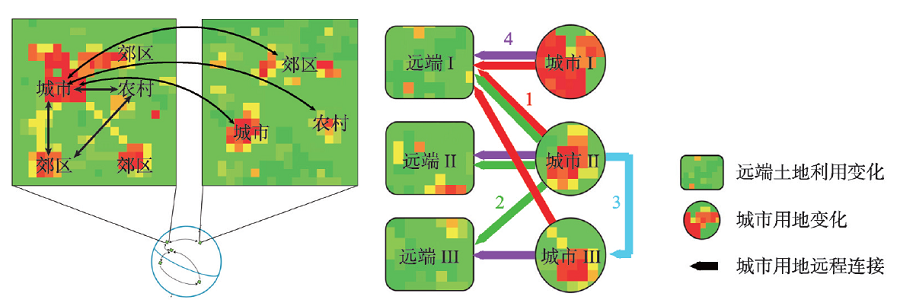

城镇化与生态环境近远程耦合关系研究进展
|
任宇飞(1990-), 男, 甘肃兰州人, 博士生, 中国地理学会会员(S110012498M), 研究方向为城市群地区城镇化的资源环境效应。E-mail: renyuf@126.com |
收稿日期: 2018-12-05
要求修回日期: 2019-11-10
网络出版日期: 2020-05-25
基金资助
国家自然科学基金重大项目(41590840)
国家自然科学基金重大项目(41590842)
版权
Progress in local and tele-coupling relationship between urbanization and eco-environment
Received date: 2018-12-05
Request revised date: 2019-11-10
Online published: 2020-05-25
Supported by
Major Program of the National Natural Science Foundation of China(41590840)
Major Program of the National Natural Science Foundation of China(41590842)
Copyright
城镇化与生态环境近远程耦合关系研究是国际人地系统研究的前沿和热点领域,对于如何协调中国城镇化与生态环境的关系问题也具有重要的参考价值。本文紧扣城镇化与生态环境近远程耦合关系研究主题,在对国际研究进行梳理的基础上,集中从城镇化与生态环境近远程耦合关系理论、方法以及关键应用领域三个方面,对城镇化与生态环境近远程耦合关系研究国际前沿与进展进行评述。分析发现,国际上近远程耦合概念提出时间不长,其理论的完备性与系统性尚显薄弱,对实证研究统领性指导还略显不足。而从其他研究视角出发,国际上对互为远端的人地系统间关联现象进行了大量研究,实证内容充足,内涵丰富。展望未来,关注城市群地区城镇化与生态环境近远程耦合关系、挖掘城镇化与生态环境近远程耦合主导路径与动态演变特征、加强中国城镇化与生态环境近远程耦合理论研究,是推动中国城镇化与生态环境耦合研究迈向新的发展阶段的重要方向。

任宇飞 , 方创琳 , 李广东 , 孙思奥 , 鲍超 , 刘若文 . 城镇化与生态环境近远程耦合关系研究进展[J]. 地理学报, 2020 , 75(3) : 589 -606 . DOI: 10.11821/dlxb202003011
The local and tele-coupling relationship between urbanization and eco-environment has received extensive attention from researchers in recent years. Understanding the synergies and trade-off between urbanization and eco-environment systems is essential in addressing eco-environment problems in rapidly urbanized China. Based on a comprehensive literature review on the subject, this article presents the theories, methods and key applications that are associated with the coupling relationship between urbanization and eco-environment. We found that the concept of local and tele-coupling relationship between urbanization and eco-environment has only been developed since two decades ago. Related theories are still in development and applications based on this concept are limited until now. However, from other perspectives, many studies have adopted various methods to investigate the relations between the human and nature systems, providing abundant empirical evidence on the coupling relationship between the two systems. Lastly, future research directions are recommended. It is essential to examine the local and tele-coupling relationship between urban and eco-environmental systems in urban agglomeration areas, which helps enhance our understanding on the dynamic characteristics of involved systems and dominating pathways of evolving relationships in rapidly developed regions in China.

Key words: urbanization; eco-environment; telecoupling; urban agglomeration; research progress
表1 远程耦合研究框架内容及未来研究方向(资料来源:文献[21])Tab. 1 Summary of five major components of tele-coupling framework and example questions for further research on tele-coupling and sustainability |
| 组件名称 | 包含内容 | 未来亟待解决问题 |
|---|---|---|
| 系统(Systems) | 发送系统(Sending) 接受系统(Receiving) 溢出系统(Spillover) | 远程耦合中的发送、接受、溢出系统的性质和演变原因是什么?系统的空间关系是怎样影响到发送、接受或溢出系统的功能定位和远程耦合作用力的? |
| 流(Flows) | 物质流或能量流(Material/Energy) 信息流(Information) … | 远程耦合要素流是怎样在空间和时间上演变的?远程耦合要素流是怎样影响两个系统的?不同的远程要素流间的相似与差别? |
| 中介(Agents) | 政府(Governments) 劳工(Labors) 公司(Companies) … | 中介是怎样在空间和时间上变化的?中介是如何影响两个系统?中介为了回应远程耦合效应和动态变化将做出怎样的改变?中介间的社会网络是怎样构成的,他们又是如何维持的? |
| 原因(Causes) | 经济原因(Economic) 政治原因(Political) 技术原因(Technological) 环境原因(Environmental) 文化原因(Cultural) … | 影响远程耦合动态变化和系统胁迫作用强度的主控因素是哪些?影响远程耦合形式的多种因素中相对来说哪个更重要?这些因素是怎样随着时间影响和变化的? |
| 效应(Effects) | 环境效应(Environmental) 社会经济效应(Socioeconomic) … | 远程耦合作用是怎样从本地至全球层面实现社会经济和环境可持续发展的?对于可持续发展问题,远程耦合和近程耦合哪一个更重要?时间对于过程的滞后性和后续效应是怎样的?三系统间的相互反馈作用是怎样的?远程耦合效应是怎样改变远程耦合系统的弹性和脆弱性的? |
| [1] |
[ 黄耿志, 冷疏影 . 国家自然科学基金推动下的中国人文地理学发展. 地理学报, 2018,73(3):578-594.]
|
| [2] |
[ 傅伯杰 . 地理学: 从知识、科学到决策. 地理学报, 2017,72(11):1923-1932.]
|
| [3] |
[ 方创琳, 周成虎, 顾朝林 , 等. 特大城市群地区城镇化与生态环境交互耦合效应解析的理论框架及技术路径. 地理学报, 2016,71(4):531-550.]
|
| [4] |
|
| [5] |
|
| [6] |
|
| [7] |
|
| [8] |
|
| [9] |
|
| [10] |
|
| [11] |
|
| [12] |
|
| [13] |
|
| [14] |
|
| [15] |
|
| [16] |
|
| [17] |
|
| [18] |
|
| [19] |
|
| [20] |
|
| [21] |
|
| [22] |
|
| [23] |
|
| [24] |
|
| [25] |
|
| [26] |
|
| [27] |
|
| [28] |
[ 孙新章 . 中国参与2030年可持续发展议程的战略思考. 中国人口·资源与环境, 2016,26(1):1-7.]
|
| [29] |
|
| [30] |
|
| [31] |
|
| [32] |
|
| [33] |
|
| [34] |
|
| [35] |
|
| [36] |
|
| [37] |
|
| [38] |
|
| [39] |
|
| [40] |
|
| [41] |
|
| [42] |
|
| [43] |
|
| [44] |
|
| [45] |
|
| [46] |
|
| [47] |
|
| [48] |
|
| [49] |
|
| [50] |
|
| [51] |
|
| [52] |
|
| [53] |
|
| [54] |
|
| [55] |
|
| [56] |
|
| [57] |
|
| [58] |
|
| [59] |
|
| [60] |
|
| [61] |
|
| [62] |
|
| [63] |
|
| [64] |
|
| [65] |
|
| [66] |
|
| [67] |
|
| [68] |
|
| [69] |
|
| [70] |
|
| [71] |
|
| [72] |
|
| [73] |
|
| [74] |
|
| [75] |
|
| [76] |
|
| [77] |
|
| [78] |
|
| [79] |
|
| [80] |
|
| [81] |
|
| [82] |
|
| [83] |
|
| [84] |
|
| [85] |
|
| [86] |
|
| [87] |
|
| [88] |
|
| [89] |
|
| [90] |
|
| [91] |
|
| [92] |
|
| [93] |
|
| [94] |
|
| [95] |
|
| [96] |
|
/
| 〈 |
|
〉 |